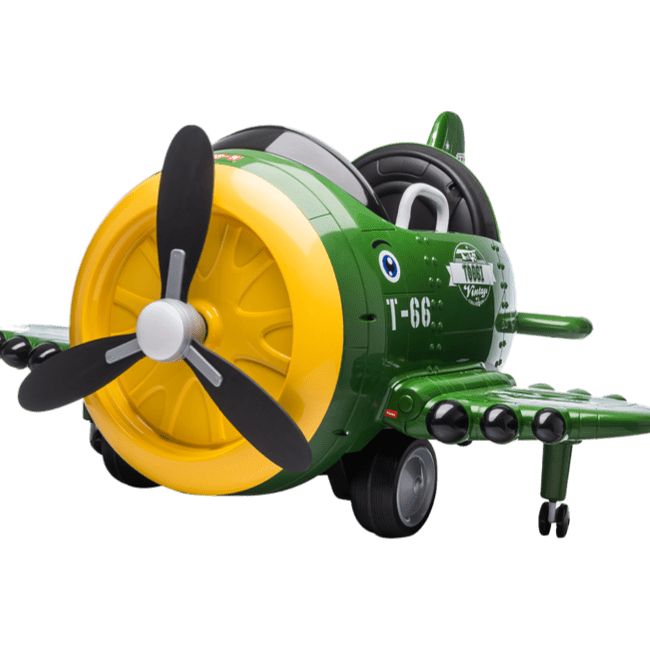- Home
- Shop
- Forest Series
- Grassland Series
- Desert Series
- Contact
- Home
- Shop
- Forest Series
- Grassland Series
- Desert Series
- Contact

Falcon Series





REMOTE PARENTAL MODE
A remote controller is equipped to allow parents to take over the control if the baby is too young to drive this aeroplane alone. Moreover, the airfoils with button lock hinges could be folded to saving storing space while the screw propeller will rotate powered by wind. The battery indication reminds you of when to recharge.
SAFE & COMFORTABLE
The 3-point adjustable safety belt perfectly fixes your baby firmly on the seat. The driving wheels are made of foam rubber, soft and highly-resilient to effectively absorb the shock and ensure an excellent grip on flat or rugged roads. Both wings are configured with an auxiliary trolley wheel which offers a significant support against excessive tipping at turning.
DISTINCTIVE GIFT FOR KID
Specially scaled down in accordance to American aircraft in Battle of Midway, this children’s electric toy car could ‘flying’ at full directions. Operated with 2 aviation control levers in the cockpit, it simulates realistic aircraft-driving. With large capacity batteries, long-time playing is assured, perfectly regarded as a present for your grandson/granddaughter on Festivals like Christmas and Children’s Day.
RICH SOUND EFFECTS
A volume-adjustable audio system adds engine sound and music to this unique baby carriage, containing functions of MP3 (with USB interface) and an FM radio that will search for valid frequency automatically. The button on the left control lever is for machine gun, and the right one aerial bomb.


CHARACTERISTICS
The Chipmunk is a member of the family Mammalia, Rodentia and Sciuridae. It is also known as the Striped Squirrel, the Timber Tiger and the Mini-bear. The body length among most Chipmunks ranges from 5.5 to 6.3 inches and the tail length is 5 Inches. Chipmunks typically weigh about 0.02 pounds and live about 5 to 10 years. They have small but prominent ears which face forwards, and small eyes on the sides of their heads. Most wild Chipmunks are lively.


Lorem ipsum dolor sit amet, consectetur adipiscing elit. Ut elit tellus, luctus nec ullamcorper mattis, pulvinar dapibus leo.


CHARACTERISTICS
Merlins are small but fierce falcons from the Northern Hemisphere. They are swift fliers and skilled hunters and have for centuries been well regarded as a falconry bird. The male merlin has a blue-grey back, ranging from almost black to silver-grey in different subspecies. Its underparts are buff- to orange-tinted and more or less heavily streaked with black to reddish-brown. The female and immature are brownish-grey to dark brown above, and a whitish buff spotted with brown below. The eye and beak are dark, the latter with a yellow cere. The feet are also yellow, with black claws.

RANGE AND HABITAT
Merlins are found throughout the Northern Hemisphere. Most of the populations are migratory, wintering in warmer regions. Northern European birds move to southern Europe and North Africa, and North American populations to the southern United States and to northern South America. Merlins inhabit fairly open country, such as willow or birch scrub, shrubland, but also taiga forests, parks, grasslands such as steppe and prairies, sand dunes, deserts, or moorland. In general, they prefer a mix of low and medium-height vegetation with some trees and avoid dense forests as well as treeless arid regions.

DIET
Merlins are carnivores and specialize in preying on small birds including sparrows, quail, larks, or pipits. Larger birds and other animals such as insects (especially dragonflies and moths), small mammals like bats and voles, and reptiles complement their diet as well.

BEHAVIOR
Habits and Lifestyle
Merlins usually lead a solitary life outside of the breeding season. However, in the winter they may roost communally or sometimes migrate in loose groups. They start migrating to the breeding grounds in late February. Migration to winter quarters, at least in Eurasia, peaks in August/September. Merlins are diurnal hunters and rely on speed and agility to hunt their prey. They often hunt by flying fast and low, typically less than 1 m (3.3 ft) above the ground, using trees and large shrubs to take prey by surprise. But they actually capture most prey in the air, and will “tail-chase” startled birds. Breeding pairs will frequently hunt cooperatively, with one bird flushing the prey toward its mate. Merlins communicate vocally and are usually noisy near the nest and during the displays. When alarmed birds produce “kikiki” or “kekeke” shrills.
Mating Habits
Merlins are serially monogamous and pairs form for one season only. Their breeding season occurs typically in May-June and during this time birds perform aerial courtship displays. Merlins do not build nests but mainly use abandoned crow or hawk nests which are located in conifer or mixed tree stands. In moorland-particularly in the UK- females usually make a shallow scrape in dense heather to use as a nest. Others nest in crevices on cliff-faces and on the ground, and some may even use buildings. The female lays 3 to 6 (usually 4 or 5) rusty brown eggs. She incubates them within 28 to 32 days while the male hunts to feed the family. Hatchlings weigh about 13 g (0.46 oz) and fledge after another 30 days or so. They are dependent on their parents for up to 4 more weeks. Sometimes first-year merlins (especially males) will serve as a “nest helper” for an adult pair. Merlins become reproductively mature at one year of age and usually attempt to breed right away.

The Chipmunk is a member of the family Mammalia, Rodentia and Sciuridae. It is also known as the Striped Squirrel, the Timber Tiger and the Mini-bear. The body length among most Chipmunks ranges from 5.5 to 6.3 inches and the tail length is 5 inches. Chipmunks typically weigh about 0.02 pounds and live about 5 to 10 years. They have small but prominent ears which face forwards, small eyes on the sides of their heads. Most wild Chipmunks are lively.
The Red Squirrel, a member of the Sciuridae, is an arboreal, omnivorous rodent often referred to as a Forest Seeder and folklore as the Devil King Squirrel.
The Arizona Gray Squirrel, also known as the American Gray Squirrel, is a member of the family Rodentia and Sciuridae. It is small in size, with gray fur and a belly between white and cream. It has long ears, no tufts of fur and a fluffy tail edged in white. The body is about 16-20 inches long and weighs up to 1.4 pounds.
The Rock Squirrel, also known as Sao Maozi or Stone Mouse, belongs to the rodent and is a species in the family Sciuridae. The most common natural predators of the Rock Squirrel include bobcats, owls, eagles and snakes. Though the Rock Squirrel is cute, alert, and courageous, it is still considered a pest due to its habit of destroying crops.
The Abert’s Squirrel is a member of the genus Sciurus with a body length of 18-22.8 inches, a tail length of 7.5-9.8 inches and a weight of 2.2 pounds, and can live up to 10 years in the wild. Its most distinctive feature is tassels of fur about 0.8-1.2 inches long at the tip of its ears, which looks very interesting. In addition, it is alert and agile.

Country Diary: the Thrilling, Terrifying Flight of the Merlin
Holkham, Norfolk: They may be small, but merlins are the most exciting of Britain’s falcons.
‘What I realised most forcibly was how the energy generated in me by this creature must mirror a surge of terror in its prey.’
From nowhere a female merlin coursed along the tide and swung over the curlews and gulls gathered there, which stared skywards as one, but hunkered still. The falcon then turned and fled as a receding dark teardrop of energy. It had somehow aligned this going within the boundary of shore and shallows, so that it was nigh impossible to follow through all the backlit foam. Within five or maybe 10 seconds, it had vanished into salt air.
The sighting was exceptional because I’ve never seen Britain’s smallest raptor hunting at the sea edge. It was absolutely typical for its brevity and speed, and only with hindsight could I unpick what had happened. The merlin had swept in, checked with near-instantaneous clarity that all the birds gathered by the shore were too big for its powers and sped off for smaller shoreline dwellers-the ringed plovers, dunlins and sanderlings – that were elsewhere on the beach.
Small size suggests perhaps that merlins lack drama. It is true that among Britain’s falcons, peregrines are grander, more theatrical; hobbies are most elastic and manoeuvrable; hovering kestrels create their magical stillness; but merlins are the most exciting. The flight is invariably low and hard, and some of the joy of the bird is your being able to fix its identity – the short, pointed wings, short tail, dark colour – in the brief moment you have it in view.
What I realised most forcibly was how the energy generated in me by this creature must mirror a surge of terror in its prey. Yet I contrasted my position with theirs. I was swathed against the northerlies and in 20 minutes we’d be taking tea and cake in a hotel. We would cut our route home with car headlights and the door would open to electricity and the sounds of central heating.
Somewhere further along this beach were the small waders that merlins love to catch, and they had no defence but the vigilance of the flock and the acidic chemistry of their fear. I imagined the moment they most dread, those black eyes growing as they come close, then that yellow thicket of talons around the hammering heart.



Follow Us: